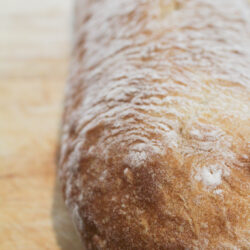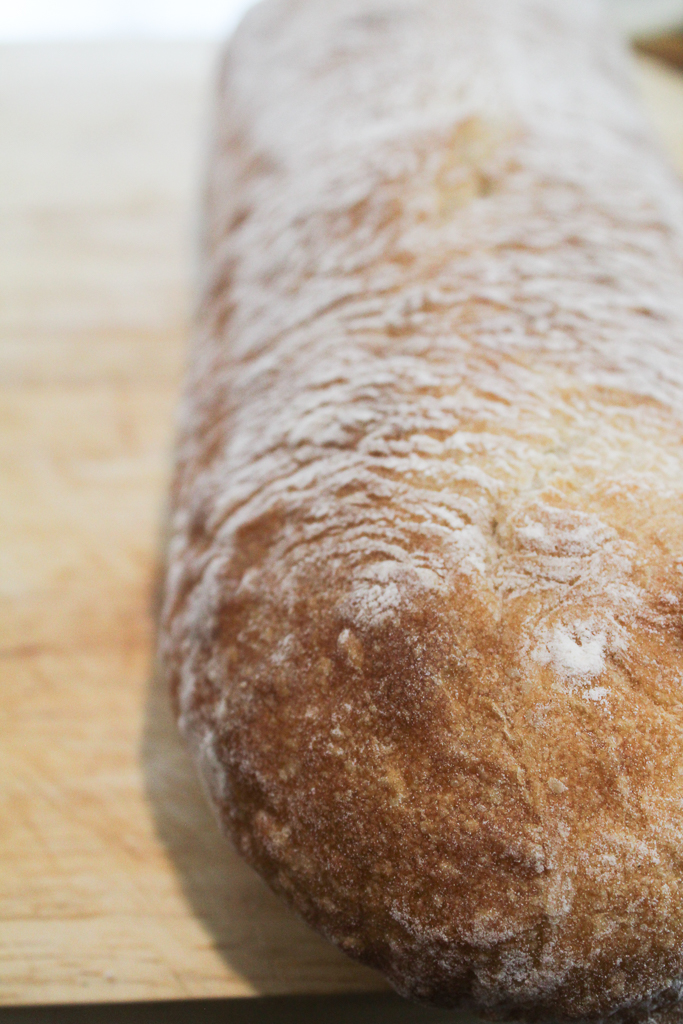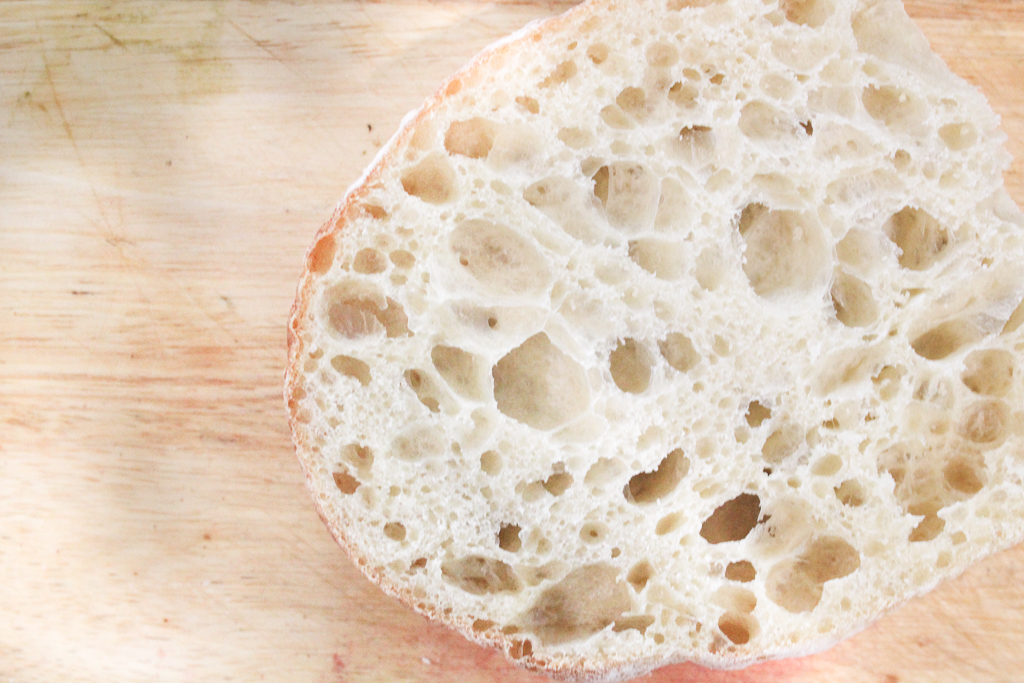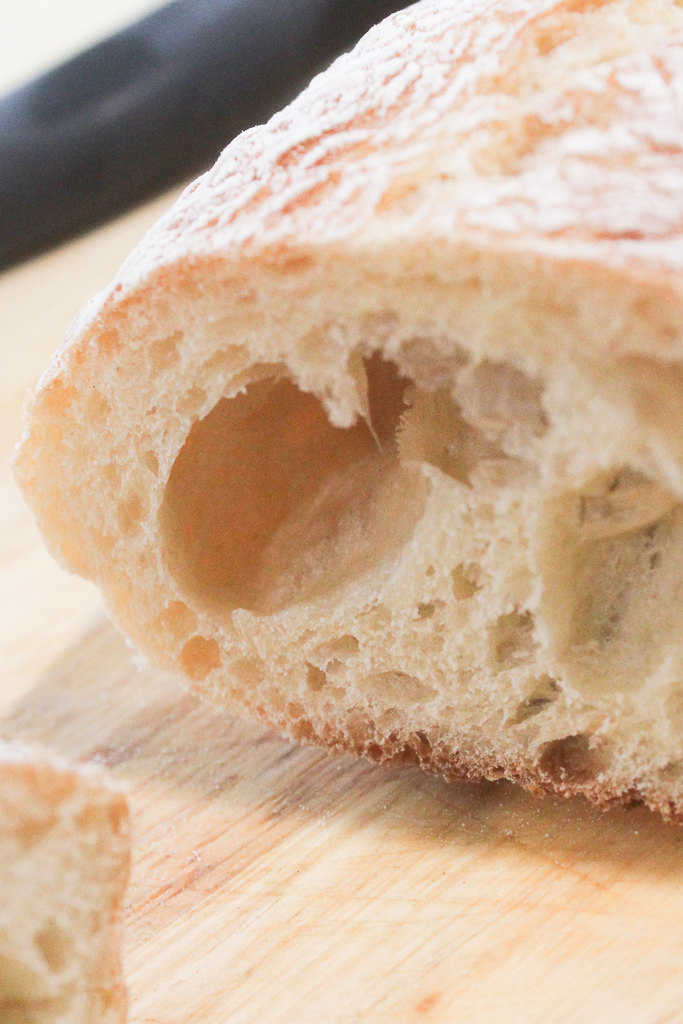This post may contain affiliate links for products that I endorse and use. If you buy from one of the links, I earn a commission at no cost to you.
Homemade ciabatta is easier than you think and perfect for toast, salads, soups, or on its own.
I recently went on a weekend trip and wanted a nice dinner to start the weekend. I made reservations at an upscale place that had an amazing-looking menu. What caught my eye was a crab appetizer that was served with grilled sourdough bread.
The appetizer and the whole meal were a big disappointment, but one of the biggest disappointments was the bread — it was generic grocery store sliced bread that was nothing more than slightly fancy Wonder Bread.
Okay, first — bread is not bread. I am not against a loaf of Wonder Bread in some situations, but it doesn’t deserve a place next to an expensive appetizer in a nice restaurant. Wonder Bread is what you eat peanut butter and jelly on when you’re camping or feeding your kids lunch.
In case you can’t tell, I have strong opinions about bread. End rant.
So this is the bread I wish I had gotten. It’s crusty and flavorful and has a nice big open crumb that is perfect for slathering with olive oil and toasting. The recipe comes from King Arthur Flour and is easy to follow with excellent results. If you’ve made homemade bread before, this shouldn’t give you any trouble.
One thing to note — if you’ve never made ciabatta, it’s a wet dough, which makes it hard to handle. You’ll be tempted to add additional flour to make it easier to knead and shape, but resist. Add as little as possible so that the dough doesn’t stick to your hands. Too much flour will prevent the bread from developing the amazing open crumb that ciabatta is known for.
For the best tasting bread, let it rise overnight in the fridge after mixing the dough. You will not go wrong, trust me.

Homemade Ciabatta
Homemade ciabatta is easier than you think and perfect for Italian sandwiches, avocado toast, or just eating with a drizzle of olive oil.
Ingredients
Biga
- 3/4 cup 170g water, cool
- 1 3/4 cups + 2 tablespoons 226g King Arthur Unbleached Bread Flour
- 1/8 teaspoon instant yeast or active dry yeast
Dough
- all of the starter from above
- 3/4 cup 170g water, lukewarm
- 1 3/4 cups + 2 tablespoons 226g King Arthur Unbleached Bread Flour
- 1 teaspoon instant yeast or active dry yeast
- 1 1/2 teaspoons 9g salt
Instructions
- To make the biga: Weigh your flour; or measure it by gently spooning it into a cup, then sweeping off any excess. Stir the water, flour, and yeast together, cover, and let rest at room temperature for 12 to 16 hours.
- To make the dough: Add the water to the biga, mixing to incorporate the two. Combine the flour, yeast, and salt in a separate bowl, and add to the biga-water mixture. Mix on low speed of a stand mixer fitted with a dough hook until the dough becomes cohesive, about 2 minutes. Increase the mixer to medium speed and knead to form an elastic, sticky dough, about 3 to 4 minutes. Resist the urge to add more flour unless the dough is truly "soupy."
- Cover the dough in the bowl, let it rise for 1 hour, then gently deflate it. Let it rise another hour, then turn it out onto a liberally floured work surface, and sprinkle lots of flour on top.
- Flatten the dough to an 8" x 10" rectangle and cut it into two pieces, each 4" x 10”.
- Transfer the loaves onto a piece of parchment, leaving about 6" between them. Cover with a lightly greased piece of plastic wrap or a freestanding plastic cover, and let rise until they're very puffy, 1 1/2 to 2 hours.
- About 30 minutes before the loaves are ready to bake, preheat the oven to 500°F. If you have a baking stone, place it in the middle of the oven when you start preheating, so it gets nice and hot.
- Spritz the dough with water; or add steam to your oven (see "tips," below). If you're baking on a stone, transfer the bread to the stone, parchment and all. If you're using a pan, transfer the loaves on their parchment to a baking sheet, and place them on a middle rack of the oven. Lower the oven temperature to 425°F.
- Bake the ciabatta until it's golden brown, approximately 22 to 25 minutes. Turn the oven off, place ciabatta on the oven's middle rack (remove the stone if you’ve used one), crack the door open about 2", and allow ciabatta to cool completely in the turned-off oven.
Notes
Storing leftovers: Bread is best when eaten as soon as possible. You can store it in plastic, but the crust will soften. It also freezes well.
Pairs well with: Roasted Pepper and Herb Tuna Salad, Double Garlic Bread
Tried this recipe?Let us know how it was!



